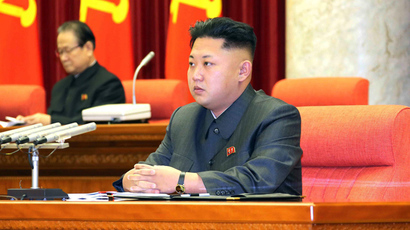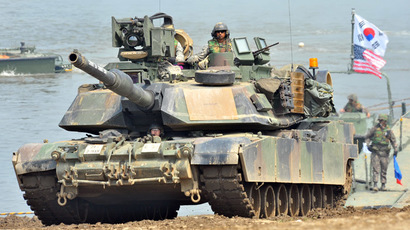US, S. Korea special forces train for guerrilla warfare in N. Korea - report

Amid an annual joint military exercise between the US and South Korea that involves thousands of troops and numerous aircraft and warships, American Special Forces groups run trainings to prepare for potential guerrilla warfare across the DMZ.
For three days in April 2013, two elite teams of 12 men each from the US Special Operations Forces carried out simulated missions into North Korea with two South Korean counterparts, the 7th and 11th Republic of Korea (ROK) Special Forces. The training - Balance Knife 13-1 - focused on how to move commandos in and out of North Korea, and how to build an “indigenous resistance organization” once inside, according to the January 2014 edition of Special Warfare, an academic journal of the US Army’s John F. Kennedy Special Warfare Center and School.
Many South Korean commandos “still have family in the North that they may or may not have contact with,” the journal said, good for growing “strong relationships that transcend NK ideology and can serve as a foundation for the development of a loyal resistance organization.”
The simulated actions are part of the larger Foal Eagle exercise conducted near Iksan and Damyan, South Korea. The US has over 28,000 soldiers, sailors, airmen, and Marines in South Korea, though the specialized training speaks to just how familiar commandos must be in case of an immediate crisis.
The elite American special forces involved are Operational Detachment Alphas 1336 and 1333, both of the Army’s Charlie Company, 3rd Battalion of the 1st Special Forces Group.
The review noted that US military experience in Iraq and Afghanistan showed a need for improved or altered methods of unconventional warfare to be successful in North Korea. And given the North has better technology than, say, the Taliban, and a largely deforested countryside, a “drastic reduction in battle command capability” requires grounded commandos be able to operate with less.
North Korea’s “robust Air Defense Artillery threat” limits helicopter capabilities, for instance. Sparse infrastructure allows for a North Korean force to patrol large areas at once. The conditions would largely require opposition troops to move at night and without convenient air or ground support in case of emergency.

“If that movement in a denied area with an indigenous resistance force results in enemy contact,” the Army journal stated, “then assets such as a quick reaction force and readily available indirect fires and close-air support will be the exception rather than the rule.”
The review said that evacuating wounded persons from North Korea could take days or even a week compared to Afghanistan, where it takes US forces an average of 42 minutes.
“During the initial-entry stage in the [Korean Theatre of Operations], the movement of wounded personnel will be from inside a denied area, across a border, to a secure area by clandestine means,” the report said, highlighting the added pressure for medics in case of emergency.
The Balance Knife exercises to prepare for worst-case scenarios on the Korean Peninsula are stressed as practice in case of a crisis in diplomacy or a sudden collapse of Kim Jong Un’s regime - comparatively less stable than his father’s. The trainings are not meant to be a backing of a potential insurgency into Pyongyang, the review said, and exercises are intended to be used for defensive preparations in case of a provocation from the North.
North Korea’s shelling of Yeonpyeon island in 2010 is the kind of abrupt incident the commando exercises have focused on in the past, Medium reported, following up on Special Warfare’s review.
Last week, North Korea demanded South Korea and the US halt their annual military drill, calling it “a serious provocation.” If the drill isn’t stopped, North-South relations “will plunge into a deadlock and unimaginable holocaust,” Pyongyang said.
“We sternly warn the US and the South Korean authorities to stop the dangerous military exercises which may push the situation on the peninsula and the north-south ties to a catastrophe,” said the spokesman for the Committee for the Peaceful Reunification of Korea (CPRK) in a statement, reported [North Korea’s] KCNA state news.
The US and South Korea, which have shared the cost of hosting American soldiers since 1991, are planning to stage military exercises in late February. This year, the US plans to boost its military presence in South Korea, pledging to send another 800 troops in addition to those 28,000 which are already in the country.














